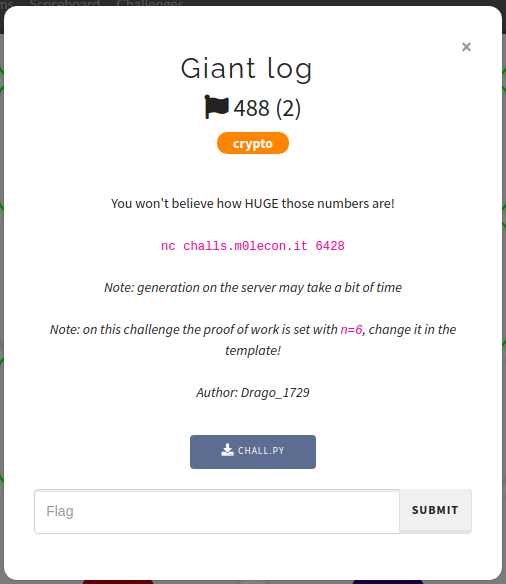m0leCon CTF 2021 Teaser — Giant log
all images are clickable
Challenge information
Files
chall.py:
import random
from secret import flag, fast_exp
import signal
p = 0x83f39daf527c6cf6360999dc47c4f0944ca1a67858a11bd915ee337f8897f36eff98355d7c35c2accdf4555b03a9552b4bf400915320ccd0ba60b0cb7fcad723
g = 0x15a5f7dec38869e064dd933e23c64f785492854fbe8a6e919d991472ec68edf035eef8c15660d1f059ca1600ee99c7f91a760817d7a3619a3e93dd0162f7474bbf
def test():
for _ in range(10):
x = random.randint(1, p)
n = random.randint(1, 20)
m = p**n
assert pow(g, x, m) == fast_exp(x, n)
def chall():
n = 1000
x = random.randint(1, p**(n-1))
y = fast_exp(x, n)
return x, y
def stop(signum, stack):
print("Too slow")
exit(1)
def main():
x, y = chall()
timeout = 60
print(hex(y))
print("Now gimme x")
signal.alarm(timeout)
x_inp = int(input(), 16)
if x == x_inp:
print("Wow, impressive!")
print(flag)
else:
print("Nope, sorry")
if __name__ == "__main__":
signal.signal(signal.SIGALRM, stop)
#test()
main()Solution
The main goal of the challenge is simple: we just need to calculate a discrete logarithm in very huge numbers. The challenge server generates a random number x ∈ [1, p], calculates y = g ^ x (mod p^1000) and prints y, then we need to find x in 60 seconds. It’s obvious that running the discrete logarithm directly will be inefficient, so we need to use a different approach.
When you see a prime power (such as p^1000 in our case), you might think of p-adic numbers. I’ll try to briefly explain what it is.
Suppose you have a prime p and an integer x. You always can write x as sum:
x = a0 * p^0 + a1 * p^1 + a2 * p^2 + ...
And x represented that way is a p-adic number. You could use something similar when you wrote a number in a binary representation (2-adic). p-adic numbers extend the ordinary integer arithmetic and also have its exponential and logarithm functions. As you know, the logarithm function for numbers has the property: log_a(b) = log(b) / log(a), so we can express x:
y = g ^ x => x = log_g(y) = log(y) / log(g)
Let’s write come sage code:
# here is some interaction with the challenge server
y = get_y_from_the_server()
# declaration of p-adic integers ring with precision 1000
Z = Zp(p, prec=1000)
# calculating the logarithm
x_Z = Z(y).log() / Z(g).log()
# lifting the solution to ordinary integers
x = x_Z.lift()
# now we can send x to the server and get the flag
flag = send_x_to_the_server(x)
print(flag)Note that the numbers are really huge, for example y has about 150k decimal digits.
Flag
ptm{p_4d1cs_ar3_t00_op}
